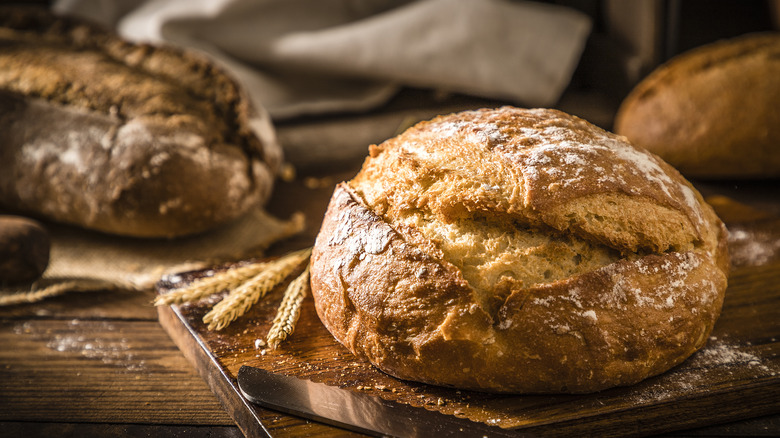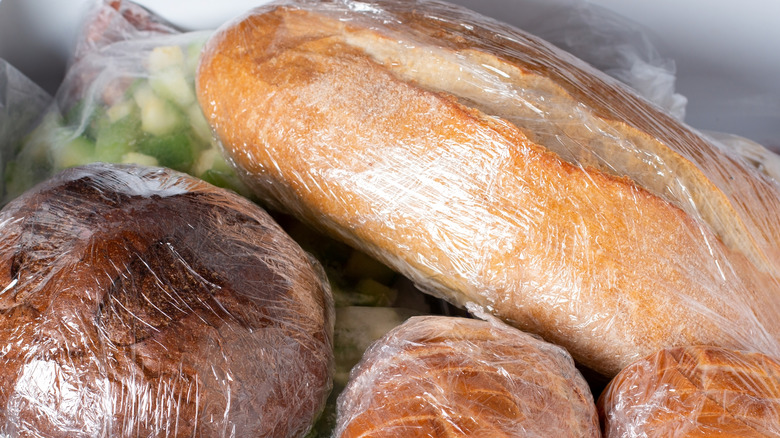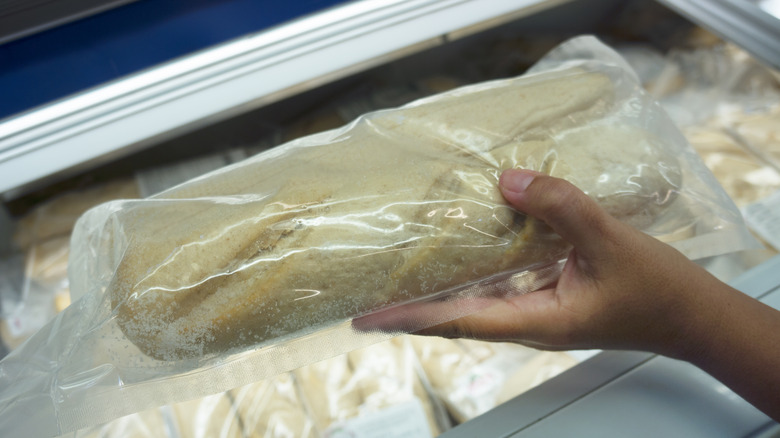Think Twice Before Defrosting Your Bread On The Counter
Storing your bread in the freezer, or buying and freezing it in bulk to skip extra shopping trips, are both savvy ways to save time and expense. However, there are right and wrong ways to defrost your frozen loaves, and thawing bread on the counter is a definite no. Moving bread from the freezer to the counter, and allowing it to defrost over time at room temperature, will cause it to go stale, which essentially means the bread loses the much-needed moisture that gives it its moreish flavor and springy freshness.
So, what's the science behind staling? It's due to a process called retrogradation and recrystallization of starch. Wheat, which is a primary ingredient in most breads, is packed full of starch. At a molecular level, starch is a crystal that holds onto water. When starch crystals meet water in the process of kneading and rolling dough, they break down and spread evenly throughout the mixture, distributing moisture.
However, when bread cools to room or even standard refrigerator temperatures, starch molecules gradually separate from water (retrogradation) to crystal compounds (crystallization) once more, releasing moisture from the bread. The longer the bread cools, the harder and dryer it becomes, and before you know it, your aromatic ciabatta is hard and flavorless.
The best way to thaw bread
How can you defrost bread while still preserving its texture and taste? The key lies in heating it immediately after it's removed from the freezer. Heating the bread as soon as possible breaks down crystallized starch so that it can reabsorb all remaining moisture, leaving you with soft, warm bread ready for butter! If you are defrosting a frozen loaf of bread, place it on a baking sheet and warm it for roughly half an hour in an oven preheated to 350 degrees Fahrenheit. You can leave your bread in the oven for five minutes more or less depending on the size and density of the loaf, or how crunchy you like your crust. Defrosting frozen slices of bread is even easier if you'd like a crunchy slice of toast: Simply pop your frozen slice in a toaster — there's no need to thaw it in the oven first.
Be sure to begin the heating process as soon as the bread is removed from the freezer: The longer bread sits on your countertop, the greater the risk of staling. Keep in mind that there's a limit to how long bread can actually last in the freezer. Frozen bread can stay at its best for up to three months; thereafter, its flavor and consistency will start to decline.
How to freeze bread
Freezing bread is a great convenience, but when done wrong, it can result in freezer burn, as well as changes in taste, color, and texture. To freeze your bread properly, first decide how you'd like to portion it after defrosting. Refreezing previously frozen bread isn't recommended because it's difficult to recapture moisture that's been lost in the defrosting process.
If you'd like to freeze slices, divide bread when it's at its freshest, seal two to three slices in an air-free freezer bag, and simply store it in your freezer. When freezing a whole loaf or sections, place the bread in a large air-free freezer bag, and store it. To avoid freezer burn, you can place your freezer bags in a cardboard box or double-wrap them with a second bag or aluminum foil. To help you use bread before the three-month recommendation, write the date of freezing on your freezer bags.
You don't need to freeze your bread if you plan to finish it soon. Even freshly baked bread (which lacks the added preservatives of store-bought loaves) can stay delicious for up to six days when stored correctly. Cooler temperatures short of freezing will only hasten the process of retrogradation and recrystallization, so don't store your fresh bread in a refrigerator if you can't access a freezer. Rather, seal it in paper, and place it in a bread box. Don't store fresh bread in plastic, as it blocks airflow and increases humidity — the perfect environment for mold!



